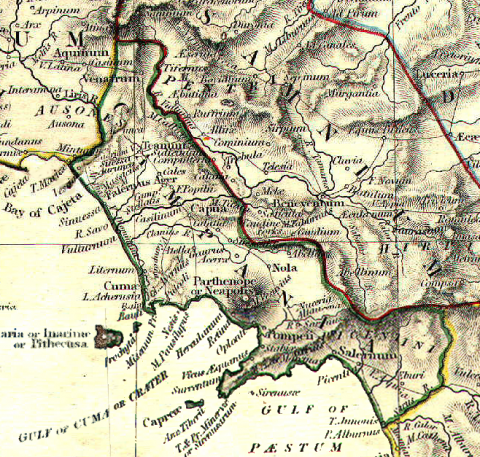The Campania Felix, so nicknamed by the Romans during the imperial period, included the territory that passing from Capua to Cumae, Caprae, Pompeii, Sorrentum, Stabia, Nuceria Alfaterna came till Salernum. All coast area, the territories in the shadow of Vesuvius and those neighboring ones were, and they also are today thanks to the arrival of million of tourists a year, a millennial meeting site of different cultures, custodians of priceless worth human natural resources. From Greek to Roman, from Lombard to Norman, from French to Spanish people, the Campania region revives its history in the streets, in the places, in the strongholds and in sumptuous imperial manors that from Miseno till Cape of Sorrento have dominated, and also today dominate, the big terrace overlooking the Bay of Naples, constituting by ever a commercial meeting point and a cultural exchange among populations that were very opposing each other.

Although the high seismic and volcanic danger, the Vesuvius and Flegrea area, colonized by the Greeks from the VIII century B.C., it was the favorite scenery for philosophers, senators, roman families’ nobles and emperors that, at the turn of the first years of the Roman Empire (first century B.C. / first century A.C. ), with their courts, had properties in the area. Large green parks, decorated environments to hold thermals districts, gyms, gymnasium remind us a world made of theater and water shows, poetic hearings, concerts, gladiators’ fights and other lots of activities that characterized the imperial life of Campania.
They were ‘Society Villas’ in which idleness, luxury and love merged to give life to magnificent banquets, while in the agricultural area of Campania were born real food industries, agricultural farms to produce cheese, oil and wine, to demonstrate another time the thriving Vesuvian production and the Pompeian amphora, founded in England, in Spain, in the ancient Gaul (the geographic area included between the northern Italy and west central Europe ), in Africa till to arrive in India. The end of the Roman Empire will mark the abandonment of the luxurious manors, the farmlands’ depopulation and the crisis of food production, while the Neapolitan subsoil will contain bishops’ wonderful tombs and crypts. A suburban city that counts about 700 cavities and occupies at least one million of cubic meters with suburban tombs, catacombs, cultural places, cemeteries, aqueducts, tanks and later also antiaircraft shelters.